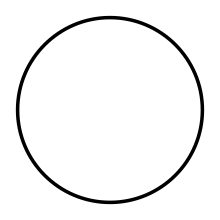That shape to the left? That is not a circle. I promise this is not a trick or a test, it really isn't a circle. So what is it then? A circleloid? No, it's actually a "megagon." No, that is not the name of a transformer, it is a polygon. A megagon is a polygon with one million sides. That is so many sides that it appears as a circle, but if you were to zoom far enough, you would eventually be able to see the edges. It would have to be a pretty intense zoom though because if you draw a megagon the size of Earth, it would still be pretty indistinguishable from a circle. Megagons are so large, it would take you over 11 and 1/2 days to draw one if you spent a second on each edge. Nobody has got time for that.
Circles themselves are pretty strange. They are a lot more complex than they look. And they're not traditional. Even though we pal them along with squares, quadrilaterals, triangles, pentagons, octagons,etc., circles are technically not polygons. Unlike every polygon in the geometric world, circles do not have a straight side. You could zoom into a circle close enough that the line would eventually look flat, but that's just your perspective. If you move far enough to the left or to the right, eventually you will notice curvature, even if it's microscopic. With squares and other polygons, you could zoom in on a flat side, and it would stay straight until you got to the edge. Then you'd just meet another straight line.
A square has 4 sides, a triangle 3. A pentagon has 5 sides and a decagon has 10. And of course a megagon has 1,000,000. How many sides does a circle have? Well that depends, but most mathematicians agree that it's either zero or infinity. Yep, a circle has zero sides. In order for a shape to have sides, it has to have vertices, which are the points (or corners) where the edges meet. A circle does not have that luxury. Yet a circle can also have infinite sides. See, infinity is not a number, so infinity and zero cannot conflict (in this case). Think of it this way: you know how sometimes you get bored waiting in the elevator and you roll along the wall? Image rolling along the edge of a triangle. Eventually you're going to encounter and roll over a pretty shape edge. Ow. Now picture a decagon with ten sides. As you roll, it'll feel like you're going over ten quirky speed bumps. A hectogon has 100 sides and looks like a circle to the naked, unaided eye, but if you were to roll along a hectogon, it would be a very bumpy experience. And if you think that is bumpy, roll along the megagon. In fairness, there'd be so many bumps that you probably wouldn't notice, but nevertheless they're there. A circle's edge is infinite because there are no bumps. It would be a very smooth journey for you along Circle Ave the entire way around.
You can also think about it this way: a line segment is a line with two endpoints. A square is made of four segments. A triangle is made of three. An octagon with eight. With a circle, you can start the line anywhere and end it anywhere. With polygons, the segments will always be on the vertices were the edges meet. Since a circle has no vertices, you can make the starting and endpoints anywhere. You can change it and change it and change it, which makes it - infinite.
It's amazing something as simple looking as circle could be so complex, but it is. Kind of like cats.

how big would a megagon have to be to see the sides
ReplyDeleteIt is myragon
ReplyDeleteyou mean myriagon?
Deletewhat is next
ReplyDeletecool, I love stuff like this because basically only you know it, its really fun to just go down a rabbit hole of facts like these and just want to tell other people about it and they turn out kinda surprised
ReplyDelete